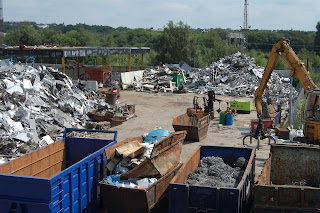There are two groups of metals; ferrous and
non-ferrous. Ferrous metals contain iron, for example carbon steel, stainless
steel (both alloys; mixtures of metals) and wrought iron. Non ferrous metals
don't contain iron, for example aluminium, brass, copper and titanium. Non-ferrous
metals do not stick to magnets. It’s a good rule of thumb that if you see rust,
it’s a ferrous metal.
Non ferrous
metals are specified for structural applications requiring reduced weight,
higher strength, nonmagnetic properties, higher melting points, or resistance
to chemical and atmospheric corrosion. They are also specified for electrical
and electronic applications.
Non-ferrous
metals are used in a wide range of applications. Non-ferrous metals industries,
considered as basic industries, are essential in the value added chain of many
investment and consumer goods producers such as mechanical engineering,
transport, aerospace, construction, packaging, electricity and energy, consumer
electronics, medical devices and others.
These are the non ferrous metals and their uses:
Aluminium
– An alloy of aluminium, copper and manganese. It is very lightweight and
easily worked. Used in aircraft manufacture, window frames and some kitchen
ware.
Copper
– Copper is a natural occurring substance. The fact that it conducts heat and
electricity means that it is used for wiring, tubing and pipe work.
Brass
– A combination of copper and zinc, usually in the proportions of 65% to 35%
respectively. It is used for ornamental purposes and within electrical
fittings.
Silver
– Mainly a natural substance, but mixing with copper creates sterling silver.
Used for decorative impact in jewellery and ornaments, and also to solder
different metals together.
Lead
– Lead is a naturally occurring substance. It is heavy and very soft and is
often used in roofing, in batteries and to make pipes.
Nonferrous
metals do not degrade or lose their chemical or physical properties in the
recycling process, resulting in their capacity of being recycled an infinite
number of times.
Non-ferrous
metals are much more malleable than ferrous metals. Non-ferrous metals are also
much lighter, making them well-suited for use where strength is needed, but
weight is a factor, such as in the aircraft or canning industries.
Because they
contain no iron, non-ferrous metals have a higher resistance to rust and
corrosion, which is why you’ll find these materials in use for gutters, water
pipes, roofing, and road signs. They are also non-magnetic, which makes them
perfect for use in small electronics and as electrical wiring. Non-ferrous
scrap metal are somewhat harder to come by and more difficult to create. This
makes the demand higher, which drives up its price.



No comments:
Post a Comment